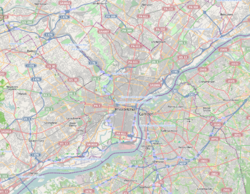Pennsylvania Academy of Fine Art
|
Pennsylvania Academy of the Fine Arts
|
|

(2013)
|
|
| Location | SW corner of Broad & Cherry Sts. Philadelphia, Pennsylvania |
|---|---|
| Coordinates | Coordinates: 39°57′18″N 75°9′50″W / 39.95500°N 75.16389°W |
| Built | 1871–1876 |
| Architect | Frank Furness; George Hewitt |
| Architectural style | Second Empire, Renaissance, Gothic |
| Website | www.pafa.org |
| NRHP Reference # | 71000731 |
| Significant dates | |
| Added to NRHP | May 27, 1971 |
| Designated NHL | May 15, 1975 |
| Designated PHMC | November 17, 2004 |
The Pennsylvania Academy of the Fine Arts is a museum and art school in Philadelphia, Pennsylvania. It was founded in 1805 and is the first and oldest art museum and art school in the United States. The academy's museum is internationally known for its collections of 19th- and 20th-century American paintings, sculptures, and works on paper. Its archives house important materials for the study of American art history, museums, and art training.
The Pennsylvania Academy of the Fine Arts (PAFA) was founded in 1805 by painter and scientist Charles Willson Peale, sculptor William Rush, and other artists and business leaders. The growth of the Academy of Fine Arts was slow. It held its exhibitions for many years in a modern building of the Ionic order designed by John Dorsey which was built in 1806, and stood on the site of the American Theater at Chestnut and 10th Streets. It opened as a museum in 1807 and held its first exhibition in 1811, where more than 500 paintings and statues were on display. The first school classes held in the building were with the Society of Artists in 1810. The Academy was reconstructed after the fire of 1845, and 23 years later steps were taken to construct a building more worthy of its treasures, the current Furness-Hewitt building, which was constructed from 1871, and opened as part of the 1876 Philadelphia Exposition.
In 1876, former Academy student Thomas Eakins returned to teach as a volunteer. Fairman Rogers, chairman of the Committee on Instruction from 1878 to 1883, made him a faculty member in 1878, and promoted him to director in 1882. Eakins revamped the certificate curriculum to what it remains today. Students in the certificate program learn fundamentals of drawing, painting, sculpture, and printmaking (relief, intaglio, and lithography) for two years, after which they enjoy two years of independent study, guided by frequent critiques from faculty, students, and visiting artists.
...
Wikipedia



